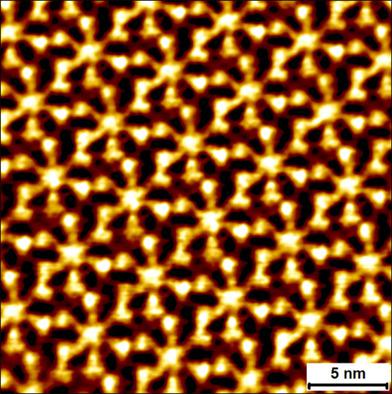当前位置:
X-MOL 学术
›
Chem. Eur. J.
›
论文详情
Our official English website, www.x-mol.net, welcomes your
feedback! (Note: you will need to create a separate account there.)
Hydrogen‐Bonded Donor–Acceptor Arrays at the Solution–Graphite Interface
Chemistry - A European Journal ( IF 3.9 ) Pub Date : 2018-08-07 , DOI: 10.1002/chem.201803115 Gangamallaiah Velpula 1 , Mengmeng Li 2, 3 , Yunbin Hu 2 , Yulian Zagranyarski 2 , Wojciech Pisula 2, 4 , Klaus Müllen 2 , Kunal S. Mali 1 , Steven De Feyter 1
Chemistry - A European Journal ( IF 3.9 ) Pub Date : 2018-08-07 , DOI: 10.1002/chem.201803115 Gangamallaiah Velpula 1 , Mengmeng Li 2, 3 , Yunbin Hu 2 , Yulian Zagranyarski 2 , Wojciech Pisula 2, 4 , Klaus Müllen 2 , Kunal S. Mali 1 , Steven De Feyter 1
Affiliation

|
Controlling the nanoscale morphology of organic thin films represents a critical challenge in the fabrication of organic (opto)electronic devices. The morphology of the (multicomponent) thin films in turn depends on the mutual orientation of the molecular components and their supramolecular packing on the surface. Here, it is shown how the surface co‐assembly of electron‐donating and ‐accepting building blocks can be controlled via (supra)molecular design. Hexa‐peri‐hexabenzocoronene (HBC) derivatives with multiple hydrogen‐bonding (H‐bonding) sites were synthesized and their co‐assembly with alkyl‐substituted perylene tetracarboxy diimide (PDI) was studied using scanning tunneling microscopy (STM) at the solution–graphite interface. STM data shows that electron‐rich HBCs co‐assemble laterally with electron deficient PDIs via preprogrammed H‐bonding sites with high fidelity. The surface stoichiometry of the two components could be readily tuned by changing the number of H‐bonding sites on the HBC derivatives via organic synthesis. This model study highlights the utility of (supra)molecular design in co‐assembly of building blocks relevant for organic electronics.
中文翻译:

溶液-石墨界面的氢键供体-受体阵列
控制有机薄膜的纳米级形态是有机(光电)电子器件制造中的关键挑战。(多组分)薄膜的形态又取决于分子组分的相互取向及其在表面上的超分子堆积。此处显示了如何通过(超)分子设计来控制供电子和受电子构件的表面共组装。六围合成了具有多个氢键(H键)位点的六苯并二氢呋喃(HBC)衍生物,并在溶液-石墨界面使用扫描隧道显微镜(STM)研究了它们与烷基取代的per四羧基二酰亚胺(PDI)的共组装。STM数据显示,富电子的HBC通过高保真度的预编程H键结合位点与缺电子的PDI横向组装。通过有机合成改变HBC衍生物上H键位的数量,可以很容易地调节这两种组分的表面化学计量。该模型研究突显了(超)分子设计在与有机电子学相关的构件的组装中的实用性。
更新日期:2018-08-07
中文翻译:

溶液-石墨界面的氢键供体-受体阵列
控制有机薄膜的纳米级形态是有机(光电)电子器件制造中的关键挑战。(多组分)薄膜的形态又取决于分子组分的相互取向及其在表面上的超分子堆积。此处显示了如何通过(超)分子设计来控制供电子和受电子构件的表面共组装。六围合成了具有多个氢键(H键)位点的六苯并二氢呋喃(HBC)衍生物,并在溶液-石墨界面使用扫描隧道显微镜(STM)研究了它们与烷基取代的per四羧基二酰亚胺(PDI)的共组装。STM数据显示,富电子的HBC通过高保真度的预编程H键结合位点与缺电子的PDI横向组装。通过有机合成改变HBC衍生物上H键位的数量,可以很容易地调节这两种组分的表面化学计量。该模型研究突显了(超)分子设计在与有机电子学相关的构件的组装中的实用性。









































 京公网安备 11010802027423号
京公网安备 11010802027423号